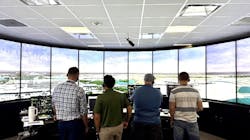Orlando International Airport Advances AAM Integration with FAA Collaboration
Aviation specialists with Orlando International Airport (MCO) recently completed an Advanced Air Mobility (AAM) assessment with the Federal Aviation Administration (FAA) using Human-In-The-Loop modeling and simulation, further paving the way to the future of air travel. Human-in-the-loop (HITL) modeling uses human insight along with automation to improve the accuracy and reliability of systems.
The three-day simulation examined the potential impacts of electric vertical takeoff and landing (eVTOL) aircraft operating in and around MCO. Using notional routes and procedures, Orlando-based Air Traffic Control Specialists evaluated integration scenarios to shape future operations, leveraging a state-of-the-art simulated tower environment lab.
The simulation occurred at the National Airspace System Innovation and Emerging Concepts Lab located at the FAA’s William J. Hughes Technical Center in Egg Harbor Township, NJ.
This is a major milestone in the FAA’s work to integrate AAM aircraft into the National Airspace System (NAS), with MCO being the second airport in the country to participate.
“This assessment reflects our drive to help lead the next evolution of flight,” said Lance Lyttle, Chief Executive Officer of the Greater Orlando Aviation Authority (GOAA), which manages Orlando International Airport. “We deeply value the collaborative partnership with the FAA, NASA, the National Air Traffic Controllers Association, and the Florida Department of Transportation (FDOT) as we lay the groundwork to safely bring new airspace entrants into the National Airspace System and position Florida at the forefront of aviation’s future.”
In November, GOAA led a two-day tabletop exercise focused on advancing the integration of AAM operations at MCO. The event, supported by several FAA organizations, explored strategies to safely and effectively introduce this new mode of air travel into the national airspace.
As part of its long-term vision, the Aviation Authority has identified two potential sites for AAM facilities; the east airfield and an area near the train station.
GOAA has invested in preparing for AAM’s future growth, including conceptual plans for vertiports. With more than 11,000 acres, Orlando International offers the size and flexibility to be a proving ground for next-generation aviation technologies.
Through ongoing collaboration with federal, state, industry, and community partners, including the FAA, U.S. Department of Transportation, and FDOT, airport leaders are hoping to position MCO and Florida airports at the forefront of AAM adoption, creating opportunities that will benefit the state.
